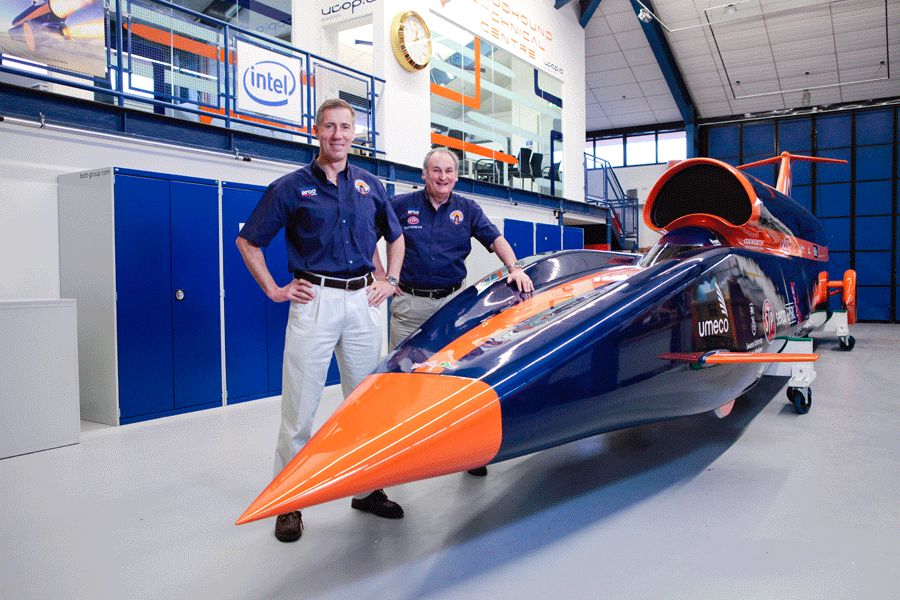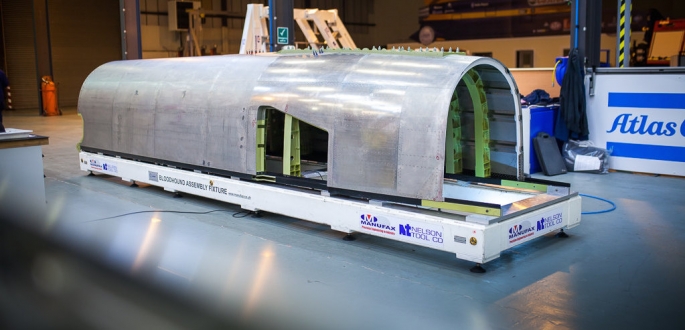
The Bloodhound Project will hold its first ever public run using the Bloodhound SSC racecar on October 26th, 2017 at the Aerohub Enterprise Zone, Cornwall Airport Newquay, U.K. The Bloodhound SSC is the world’s most advanced straight-line racing car. This will be part of a series of key development tests for the jet engine, car, and team — a key step in reaching the project’s goal of build a car capable of traveling over 1,000 mph. The runway trials take place 20 years after Thrust SSC set the current World Land Speed Record of 763.035 mph.
The runway trials will mark the culmination of a month of tests to prove the car’s steering, brakes, suspension, data systems, and other components, as well as the EJ200 jet engine, sourced from a Eurofighter Typhoon. Thousands of visitors are expected to come and see history being made as BLOODHOUND SSC is driven at speeds of up to 200mph on the 1.7 mile (2.7km) runway.
The BLOODHOUND Project is a global “Engineering Adventure”, which is using the 1,000 mph world land speed record attempt to inspire the next generation to explore and get involved in science, technology, engineering, and mathematics. The project also aims to share this iconic research and development program with a global audience, bringing engineering to life in an most exciting way possible. The project sponsors included major OEMs, such as Geely, Nammo Group, and Rolls-Royce, as well as aluminum companies and organizations, such as Trimet Aluminium AG, Innoval Technology, alimex UK Precision in Aluminium Ltd., and Aluminium Federation (ALFED) — among numerous other product and SME sponsors.
Lightweight Engineering for High Speeds
The Bloodhound SSC will not only be the fastest car in the world, but also needs to be the strongest in order to withstand the enormous forces generated by its power plants, supersonic air flow, and 90 kg solid aluminum wheels spinning at 10,200 rpm or 175 times per second, pulling 50,000 G. This presents unique engineering challenges, as the vehicle will have to endue extreme forces. When designing the lightweight aluminum wheels of the vehicle, engineering and design analysis was provided by Lockheed Martin and material expertise was provided by Innoval Technology.
The body of the car is essentially comprised of a carbon-fibre monocoque front section joined to a steel, aluminium, and titanium rear chassis. The upper chassis is fitted to the lower chassis and cockpit section. This part of the car is constructed like an aircraft fuselage, with aluminum ribs and titanium stringers and body panels. The titanium skin will be joined to the rear chassis with the help of 11,500 aerospace-grade rivets. Sitting between the ribs and the titanium is a layer of very strong glue. The EJ200 jet hangs from a single mounting point on this upper chassis, above the car’s rocket motor, made by Nammo, a supplier to the European Space Agency based in Norway, which is mounted within the steel trellis lower structure.

The construction of the lower chassis build was completed over the course of 30 months, which is made up of 77 major parts in the lower chassis, including machined and fabricated components of titanium, steel, and aluminum. Hampson BHW Wigan manufactured all of the machinings, large fabrications, and final assembly, supported by a syndicate of Product Sponsor companies, including: Thyssen Krupp for supply of the steel, titanium, and aluminum material; Jaivel for the programming for the cutting machines; Manufax Nelson for design, manufacture, and commissioning the assembly fixture, with support from TATA UK for the steel. AMADA supplied the laser cutting and folding the panels to shape and pilot drilling holes where required. WESCO AIR provided support for rivets, while DC Electronics fabricated the 2.2 km wiring loom with support from Servo Interconnect and Deutsch for the electrical interconnectors.
The rear diffuser, which is the panel that goes underneath the car between the rear wheels, is a complex shape that has to handle huge loads. Nuclear AMRC constructed the component from a 480 kg piece of aluminum, which was machined down to the final 55 kg piece over the course of 192 hours of intensive effort.
Runway Trials
In October 2017, Wing Commander Andy Green, current holder of the World Land Speed Record, will drive the car for the first time at Cornwall Airport Newquay, putting it through its paces. This will be his first opportunity to drive the car and experience the steering feel, throttle and brake action, noise and vibration — aspects that can’t be simulated. It will also be the Bloodhound Team’s first opportunity to train the support crew, as well as develop the car’s operating procedures, prove and refine the safety protocols, and practice radio communications, before heading overseas in late 2018.
“The runway trials at Cornwall Airport Newquay will be the biggest milestone in the history of the Project so far. They will provide important data on the performance of the car and give us a first opportunity to rehearse the procedures we’ll use when we go record breaking,” said Richard Noble, Bloodhound’s project director. “Just as importantly, it is a way of saying ‘thank you’, to the schools, students, families and companies, big and small, who support The Project. We are proud to be waving a flag for British skills and innovation on a world stage but, most of all, this is about inspiring young people. Last year alone we directly engaged with over 100,000 students in the UK and we have already seen more students take up engineering as result of Project Bloodhound. With the Car running, we can showcase science, technology, engineering and mathematics in the most exciting way possible. Bloodhound is Go!”
Gavin Poole, chairman of the Aerohub Enterprise Zone board and a board member of the Cornwall and Isles of Scilly Local Enterprise Partnership, said: “The Bloodhound team has already been using Aerohub to test components so we can’t wait to welcome the complete car. It will be very exciting to see the world leading engineering, aerodynamics, computing and jet engine moving at speed. Bloodhound is an inspirational project that is making the most of Cornwall’s excellent testbed facilities. We’re really looking forward to welcoming the Bloodhound team.”
